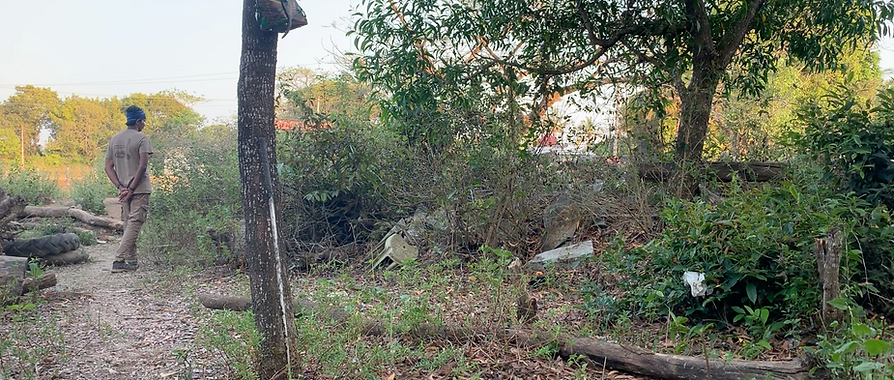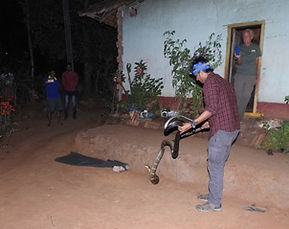
Ajay Giri






Video Credit: Save the Snakes
EcoSapiens Published: 11th June 2019
Jungle stories: How conservationist Ajay Giri is educating locals in and around Agumbe region about King Cobras and why they should be preserved
The Karnataka-based conservationist and researcher has been studying King Cobras for years now and aims to protect the biodiversity at Agumbe Rainforest Research Station
Edex Live
Ajay Giri using a device to track wild King Cobras in the Radio Telemetry Project (Pics: Shimoga Nandan)
The Western Ghats in South India have been home to King Cobras for many years. Therefore in 2005, Romulus Whitaker, the famous herpetologist and Padma Shree awardee, had set up Agumbe Rainforest Research Station (ARRS), an organisation to initiate studies not only on King Cobras, but the flora and fauna of Agumbe and Central Western Ghats of India. Ajay Giri started his journey with ARRS and dedicated his life to saving King Cobras and educating people about the majestic snake, their ecology and importance in the eco-system.
Ajay Giri is originally from the city of Akola in Vidarbha, Maharashtra. He was only 15-year-old when he developed an interest in rescuing snakes, birds and mammals. After completing his Bachelor’s in Commerce from a university in Akola, he moved to ARRS in 2009 to work as a Research Associate for one of their projects. He says, "Though I don't come from a Science background, I was always curious to learn and work in the wildlife sector. This is what brought me to Agumbe from Akola. After joining ARRS, I pursued a Master’s in Environment Science from a university in Nagaland through correspondence. It was only in college that I heard about ARRS which was working for the conservation of King Cobras found in the Western Ghats. Since 2009, I have been part of every project executed for King Cobras."
Starting with snakes
The first project that Ajay took up at ARRS was King Cobra Radio Telemetry Project under which, a chip-size transmitter is fixed in the coelomic cavity of a King Cobra and the snake is released into the wild. Then, these reptiles are tracked to understand the path they take, food consumption habits, habitat preference, mating and their reproduction cycle. Ajay says, "While transmitters were used in other animals to study them in different parts of the world, ARRS was the first organisation to use transmitters to track and study wild King Cobras. In the first phase, we inserted transmitters in four King Cobras. Every day, we would track them and monitor their activity until they went to sleep. I still remember how one female King Cobra, which had our transmitter fitted in it, was consumed by a male cobra. That's how our research lead to the understanding of cannibalism in these reptiles. Currently, the project is in its second phase where we have fixed transmitters in two male King Cobras."
Biggest threat: Rubber plantation, road widening and deforestation are the bigger threats to his indigenous wildlife
Gradually Ajay rose to different positions at ARRS. Currently, he works as a Field Director. Apart from handling the radio telemetry project, he is involved in two other projects, Human-Snake Conflict Mitigation Project and King Cobra breeding biology project. These two projects are designed to teach the lifecycle of King Cobras in a step-by-step method. Explaining further about these two projects, Ajay says, "There are agricultural lands and homes around the Western Ghats and the rain forest region in Agumbe. We come across many cases of human-King Cobra conflict on a regular basis. Whenever people find King Cobras in their homes or on their agricultural land, they call the Forest Department who in turn call us and we rush to the spot. We usually work within 100 km radius from Agumbe. We rescue the reptile only in the worst case scenarios like, if it is found on the ceiling of the house or found in a kitchen or a bathroom. If it is found near the house or in a burrow, then we try to convince the local to let it move into the woods without any disturbance. There is another misconception people have about us, they think that we capture them in cages, which is not true. We believe in their right to live in their habitat."
Ajay further adds, "During this whole process, we educate people about snake ecology, prevention and precautionary measures and steps to follow in case of snake bites. I ask people about when they spotted these King Cobras and make them understand that most of the female King cobras build a nest and lay eggs during their breeding season in the month of March and April. Meanwhile, more than one or two male King Cobras will follow the female’s scent trail for mating. In such cases, I request locals to observe them from a distance and don’t disturb them. When some people find it difficult to understand, I show them pictures and videos of previously documented King cobra behaviour. I have conducted many such programmes with the local villagers around Udupi, Shimoga and Chikkamagaluru districts whenever snakes or King Cobras were rescued." After these awareness programmes, people have truly learnt the basic steps. Now, whenever they find a King Cobra, they call Ajay while they observe the snake from a safe distance
His way of living: Ajay Giri has been into this work of rescuing King Cobras forinvolved in rescuing snake since 25 years
Ajay says that the interesting part of the female cobras is that they build a strong nest ground with the use of dry leaf litter to prevent the eggs from heavy rain and from other animal. "In the Western Ghats, neither guard the nest nor incubate them until they hatch. It leaves the place once its work is done. The eggs hatch by themselves. But in many cases, when the female Cobras lay eggs near human settlements, I along with in-charge forest department officials help convince the locals not to disturb the nest and reassure them that the hatchlings will be safely secured and released at a safe distance from their homes. After confirming that the female has left the nest, we build a barricade around the nest to create a safe space for the hatchling as well as people living nearby," he explains.
It is in this stage that Ajay brings school,college students and locals into the picture. They are brought to the place where these eggs are hatched and explained about the King Cobras, ecology, breeding methods and why they shouldn't be killed. According to his observation, it takes about 80 to 100 days for the eggs to hatch. Once these eggs hatch, Ajay collects scientific data like the number of eggs, male and female hatchlings, their length and weight. Then, these baby King Cobras are left into the wild in the presence of in charge forest department officials and locals..
When asked about the diet they consume and their behaviour, Ajay says, "In India, King Cobras exclusively feed on spectacled cobra rat snakes and vipers in India. While occasionally King cobras feeding on python and monitor lizard. If they sense a venomous snake, then they attack it on the hood and hold it in the mouth until the snake is paralysed. In the case of non-venomous snakes, they attack any part of the snake's body. Due to their cannibalistic behaviour, the larger King Cobras feed on smaller King Cobras too. They are elusive-natured and prefer to stay under canopies, in bushes and trees. King Cobras usually don't come out when there are animals like dogs, cats or even a hen around."
ARRS is open to anyone and everyone who has the interest to learn about wildlife. People, especially kids, can visit the place, observe the functioning and gain knowledge to spread awareness
Ajay Giri, Field Director, ARRS
Ajay’s latest project involves him tagging every rescued King Cobra in and around Agumbe region. He says, "It is called Passive Integrated Transponder Tagging in which, the tag is as small as a grain. It is inserted between the muscle and skin of a King Cobra. Like the Radio Telemetry transmitter, it doesn't need any battery to function. Till date, we have tagged 140 King Cobras. I will need two more years to tell an approximate population of the King Cobras in Agumbe rainforest."
Ajay hasn’t gone home for two years now. He says, "My work and projects, undertaken for the betterment of forest and animals, keeps me engaged. Even my parents have been very cooperative. Earlier, they were concerned and worried about me getting attacked by animals or snakes. Now, they understand that my work involves much more than handling animals or snakes."